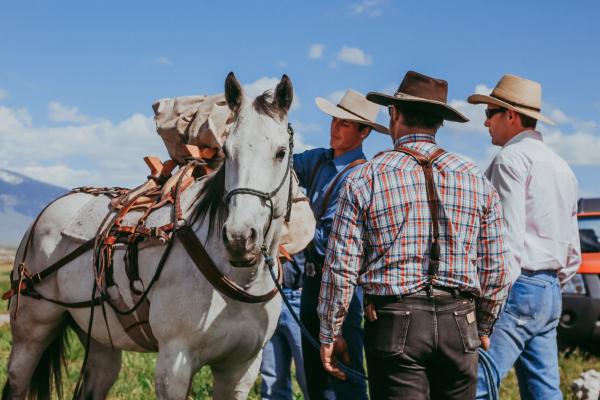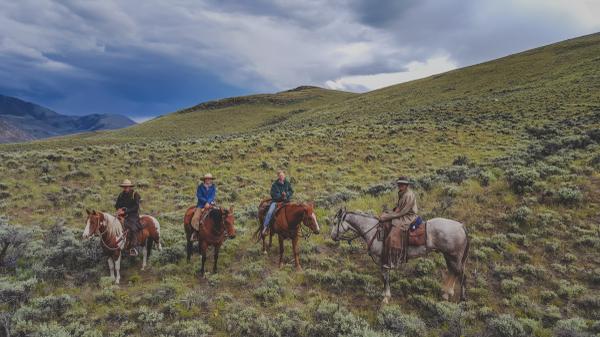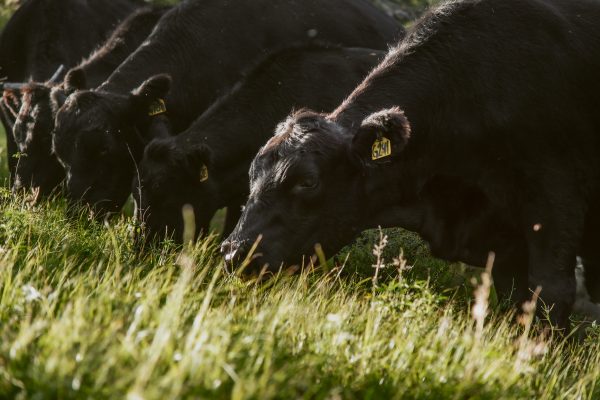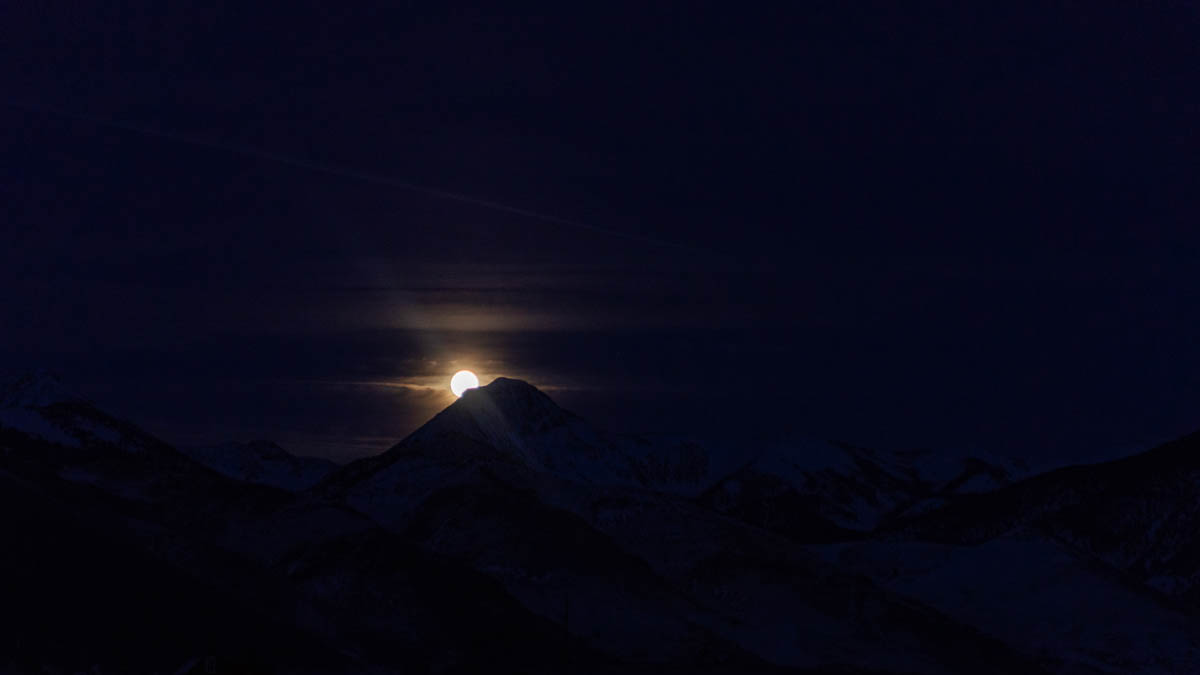On this May 12, treachery is about. I wake this morning with the first light of dawn, and I see the telltale signs that winter has attempted a coup while we rested. She crept back with her weakened forces and attempted insurgence on our valley under cloak of darkness: a solid line of demarcation between spring and winter is painted on the hills at 6000 feet. Above, all is white. Below: the color green. Springtime held firm, and set line on landscape: go no further, she said. I know spring will win in the end.
Other newness awaits discovery on the ranch today. I’m guessing there are more Angus babies born in the night; yesterday I counted 5 newborn calves that needed tagged. And there are new humans about; as I pulled my stock trailer back into the ranch at close to midnight last night, weary from fighting wind and whipping rain and snow on a horse buying trip to the next valley, I saw that the bunkhouse lights burned bright and warm through the blustery black; two new cowhands had arrived, and were getting settled in. Two more gals are scheduled to arrive today. One is from New Jersey; the other from Indiana.

I’m guessing they’ll be surprised as any about the new snow. I’m hoping they came prepared and believed my warnings about how cold and wet can blanket the mountains they’ll live and work in. I remember when I first showed up in the high desert myself. I was 19, and it took a bit to get used to; I loved it, that was sure, but I didn’t know if I could live in it. It took a while for the landscape to work its way deep, permeating the core of my being. Now, it is inextricably stuck there. Like the few other long timers we share this country with, it is unthinkable to live somewhere else. But the contrasting country is certainly not for everyone. There are high snow fields and scalding dry desert, rivers and alpine rocky peaks, verdant pine forests and floating fens, and azure blue tarns full of cutthroat trout and cracked desert pavement with rattlesnakes and lizards. It’s all jumbled together, and we see it all on our summer ranges.
Sean and Willie were two of those new college-age hands a few years back. Melanie and I handed the stockmanship baton to them at Magpie Springs Camp. It was the first range outpost that year; we’d only been riding horseback out of there for about a week. It was about 3 miles out of the Salmon River canyon, up a rocky trail that led to a tiny flat spot smack dab in the middle of rugged volcanic breaks. It was just past this time of year- late May. Snow still cloaked the peaks, but the rain-shadow desert where Magpie Springs was situated was emblazoned with spring flowers and green grasses, a surprisingly diverse plant community that ranged from cactus to the endemic Salmon River wildrye.
It was a tough camp, wedged between the rattlesnake infested rocks. It was hard to find level ground to sleep on. It would be a miserable camp in the unrelenting heat of late July and August, but in May Magpie was resplendent in the green and brightly colored mantle of ephemeral grasses and forbs, the gift of spring snowmelt. These are the same plants that our wild elk and bighorn sheep relish, as we all pick our way over the sands and rocks of the richly mineralized soil that is the legacy of our volcanic landscape.
Then, as quick as the green-up hits these rugged canyon breaks, the heat comes and gentle green becomes brittle brown. By that time, we have left only tracks behind us, and have moved on with the native graziers to higher elevation, following the green as it too leaves for the high mountain country and ever verdant forests.
But for now, it was all green for Sean and Willie. They were well victualled in camp, and despite the rough surroundings, could live quite comfortably after a long day in the saddle. But it was the siren song of all that creature comfort- a nice lunch menu from the camp cooler followed by freshly ground coffee and the promise of siesta to cap it all off- that was their undoing.
By early afternoon, they had their herd of 200 cattle well placed on a beautiful native grassland ridgetop overlooking the Salmon River canyon country. It was a room with a view. The bluebunch wheatgrass and Salmon River wildrye waved tall in the wind, and the beeves ate with abandon, relishing the rich grass. They were ancient bison, living the high life. And, when their bellies distended with fill, one by one, they decided to fold their legs and lay down in the tall grass, as the breeze tilted the deep green before them.
 Sean and Willie did the same. Everything was well in the world. They chatted of their other lives, when they weren’t riding high in the saddle: of higher education, and hopes and dreams. And as, young men would upon occasion, they would speak of women. And the lack of them, or any human for that matter in the remote country they would live in for the summer. Perhaps to balance such realizations, when townsfolk asked Willie about life on the range, I’d often hear a conversation that would go something like this:
Sean and Willie did the same. Everything was well in the world. They chatted of their other lives, when they weren’t riding high in the saddle: of higher education, and hopes and dreams. And as, young men would upon occasion, they would speak of women. And the lack of them, or any human for that matter in the remote country they would live in for the summer. Perhaps to balance such realizations, when townsfolk asked Willie about life on the range, I’d often hear a conversation that would go something like this:
“So Willie. What’s it like up there, on horseback for days at a time, living in the middle of nowhere?”
“Oh, it’s all good. I’ll get to share my birthday with 200 of my closest friends.”
Or, I’d heard this several times when he’d discuss the broad treeless expanse of the Bear Basin Country, where camp 2 was for several years:
“So Willie. Isn’t it lonely up there? I mean, don’t you miss your friends? There is like
nothing up there except grass and sagebrush.”
“Well, the nice thing about Bear Basin is that there is a pretty girl behind every tree.”
So here we have our young charges, with cattle settled, under a lovely cloud studded azure sky, breeze of thick fragrant air coursing over their contented cattle chewing cud. Willie and Sean are in the shade of their horses, drifting off in equine dreams of their own. All is well.
The next day, I’m down at ranch headquarters, trying with Josh, Ethan and the girls to hold it all together here; there are cows calving, fences to fix, irrigation water to spread, and the inevitable books to keep; it is dawn and I’m for now deskbound. The sun is just creeping into the valley over the broken horizon of rugged peaks. The cell phone vibrates next to my second cup of coffee. It’s Willie.
“Yeah Willie. How’s it going?”
“Not real good.” He paused and sounded like he was breathing hard.
“What’s up?”
“Well, we brought the cattle down off the ridges last night, and bedded them down at Magpie Camp, and took a head count.” Long pause. “We’re short.”
“How short?”
“Near as I could tell, about a hundred head.”
“What?” I nearly choked on my coffee. “You are missing over half the cattle?”
“Yep. We saddled back up, and have been riding all night, looking for them. We haven’t even cut a track. They are gone.”
“How can this be? How do you guys go missing 100 head?”
“Well, see, we had ’em settled real well in the mid afternoon; they were all bedded down on that high ridge with full bellies. So Sean and I looked at each other, and well, we thought it’d be sure nice to head down to camp real quick for a hot meal and a cuppa coffee. So that’s what we did: we loped down to camp on horseback and got resupplied. When we got back up there, well, they were still layin’ down. So we figured we didn’t miss anything. But that’s when those hundred head gave us the slip.”
Siren song.
“And you didn’t notice that maybe you were short?”
“Well, the grass and brush was tall, and we figured they were bedded down in there.”
I didn’t press Willie any more. He sounded sheepish, and felt pretty embarrassed about their loss. I went upstairs and kicked Melanie out of bed with a quiet but firm statement:
She’d heard it before.
It was technically the near the end of Willie and Sean’s shift. Melanie and I just rode horseback into Magpie Camp (10 miles from headquarters) earlier than we intended. Time was of the essence. One hundred head of yearling cattle could wander 20 miles easily a day in our open range unfenced country. The topographic relief of it could hide them for days. Some of my neighbors use airplanes to find missing cattle. We’ve used them sparingly; a good eye for a track or just knowing what sends cattle off usually yields success.
By late in the morning, Melanie and I were up on the ridge where the wayward bovines cut and run. She cut the telltale tracks first. They were on 6″ wide elk trail through the tall grass; there, in the volcanic ash dust was a single file signature of many cattle that meandered over grassy hill and dale into a defile that headed straight back down to the Salmon River Canyon. They looked just like elk tracks to the untrained eye, because yearling cattle are exactly the same size as elk prints. The difference is subtle: elk tracks are round; cattle are just a tad oblong. But we had found what we were looking for. They had to be down in the thick trees along the river, several miles away.
We rode down the long gulch, toward the river, resplendent in the early morning sun. “Look!” said Melanie.
Down at the bottom, several miles away, about a hundred head of cattle were spread out along the trail to Magpie. Going back up to camp. We stood for a moment, trying to figure out the why. And then we saw it: it was Joshua, another one of our cowhands, singlehandedly guiding the entire wayward part of the herd back up to Magpie. Apparently he had gotten a text or a phone call regarding the situation, and also had sprung into action.
Melanie and I longtrotted back down the gulch, and rendezvoused with the beeves and Joshua. And within several hours, we connected again with the other cattle, still under the sleepless hands of Willie and Sean, and relieved the sheepish cowboys from their watch. Their grateful, saddle burnt bodies and their horses turned back to camp and eventually the ranch for a much needed break; they’d been riding on and off for over 24 hours.
In a few days, they would be back to camp for their next stint. Now, they’ll be armed with another range life lesson under their belt. And by the end of the summer, they’ll be hands. And they’ll leave better, with a little more resolve for whatever the world dishes out to them as well.
They always do.

Our new cowhand 2018 crew is almost gathered. From nearly 50 applicants, most of whom were great, we selected 6 that were excellent. They’ll spend the next two weeks learning about cattle, horsemanship, wilderness camping, and rangeland ecology, with sessions taught by Caryl and I, some friends, and some of the returning cowhands. We’ll teach them about how to get the cattle to the best grass, and fill them with wild goodness. It’s going to be a great summer.
They’ll learn how to move our beeves quietly and respectfully across our wilderness ranges, while harvesting the pristine grasses for the best beef. They’ll be trained about how to keep all cattle under their direction at all times, and live with them. We call it Inherding. It is our innovative technique of fully controlling and living with our beeves using lessons we’ve learned from French Alpine herders and African natives who run cattle with non-lethal interactions in lion habitat (we have mountain lions, wolves and bears). It’s the first time that we know of since the 1800s that this type of management is being employed in American ranges.
Inherding protects and enhances all native habitats we graze on. We leave fish and wildlife habitat intact for them without fences. Our crews learn ancient traditions of stock handling so they can carefully and precisely direct grazing impacts where we want them—and not ever where we do not.
There’s saddle gear to repair, horses to shoe, and camp gear to fix. There are horses to tune up to working with their human partners, and cattle to train to herding. We have a lot to do in the next two weeks, but we’ll get it done. We are getting good at this; this is our fourth year practicing inherding, and our 25th year raising grass fed beef.
And that’s where you come in. All this preparation costs money, of course. So we’re not asking for your money for nothing. This is not a “go fund me”, or Kickstarter. All we’re asking is that you buy some beef this weekend, while capturing ten percent when you use “wildcow.” Everything in the webstore qualifies. Any order size, any order type. And through your purchase of the best protein, you’ll be partners with us in trying to rewrite regenerative grazing practices on wild Western landscapes.
Happy Trails!
Glenn, Caryl, Girls and Cowhands at Alderspring.








Leave a Reply